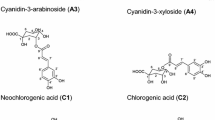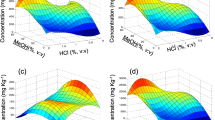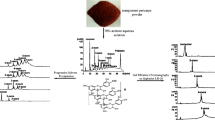Abstract
Cocoa beans contain secondary metabolites ranging from simple alkaloids to complex polyphenols with most of them believed to possess significant health benefits. The increasing interest in these health effects has prompted the need to develop techniques for their extraction, fractionation, separation, and analysis. This work provides an update on analytical procedures with a focus on establishing a gentle extraction technique. Cocoa beans were finely ground to an average particle size of <100 μm, defatted at 20 °C using n-hexane, and extracted three times with 50 % aqueous acetone at 50 °C. Determination of the total phenolic content was done using the Folin-Ciocalteu assay, the concentration of individual polyphenols was analyzed by electrospray ionization high performance liquid chromatography-mass spectrometry (ESI-HPLC/MS). Fractions of bioactive compounds were separated by combining sequential centrifugal partition chromatography (SCPC) and gel permeation column chromatography using Sephadex LH-20. For SCPC, a two-phase solvent system consisting of ethyl acetate/n-butanol/water (4:1:5, v/v/v) was successfully applied for the separation of theobromine, caffeine, and representatives of the two main phenolic compound classes flavan-3-ols and flavonols. Gel permeation chromatography on Sephadex LH-20 using a stepwise elution sequence with aqueous acetone has been shown for effectively separating individual flavan-3-ols. Separation was obtained for (−)-epicatechin, proanthocyanidin dimer B2, trimer C1, and tetramer cinnamtannin A2. The purity of alkaloids and phenolic compounds was determined by HPLC analysis and their chemical identity was confirmed by mass spectrometry.






Similar content being viewed by others
References
Othman A, Ismail A, Ghani NA, Adenan I. Antioxidant capacity and phenolic content of cocoa beans. Food Chem. 2007;100:1523–30.
Pedan V, Fischer N, & Rohn S. Fractionation of condensed cocoa polyphenols using semi-preparative NP-HPLC. 44. Deutscher Lebensmittelchemikertag (Lebensmittelchemische Gesellschaft), Karlsruhe, Germany. 2015; ISBN 978-3-936028-93-5: 119.
Khallouki K, Haubner R, Hull WE, Erben G, Spiegelhalde B, Bartsch H, et al. Isolation, purification and identification of ellagic acid derivatives, catechins, and procyanidins from the root bark of Anisophyllea dichostyla R. Br Food Chem Toxicol. 2007;45:472–85.
Honda S, Takahashi T, Kamimura A, Matsuoka T, Kanda T, Yanagida A, & Hieda K. Process for purification of proanthocyanidin oligomer. European Patent Application EP. 2000;1 666 476 A1 .
Shibusawaa Y, Yanagidaa A, Isozakia M, Shindoa H, Ito Y. Separation of apple procyanidins into different degrees of polymerization by high-speed counter-current chromatography. J Chromatogr A. 2001;915:253–7.
Marston A, Hostettmann K. Counter-current chromatography as a preparative tool—applications and perspectives. J Chromatogr A. 1994;658:315–41.
Hopmann E, Minceva M. Separation of a binary mixture by sequential centrifugal partition chromatography. J Chromatogr A. 2012;1229:140–7.
Esatbeyoglu T, Wray V, Winterhalter P. Isolation of dimeric, trimeric, tetrameric and pentameric procyanidins from unroasted cocoa beans (Theobroma cacao L.) using countercurrent chromatography. Food Chem. 2015;179:278–89.
Yang C, Li D, Wan X. Combination of HSCCC and Sephadex LH-20 methods. An approach to isolation and purification of the main individual theaflavins from black tea. J Chromatogr B. 2008;861:140–4.
Zhou X, Liang J, Zhang Y, Zhao H, Guo Y, Shi S. Separation and purification of α-glucosidase inhibitors from Polygonatum odoratum by stepwise high-speed counter-current chromatography combined with Sephadex LH-20 chromatography target-guided by ultrafiltration-HPLC screening. J Chromatogr B. 2015;985:149–54.
Cheel J, Minceva M, Urajova P, Aslam R, Hrouzek P, Kopecky J. Separation of Aeruginosin-865 from cultivated soil cyanobacterium (Nostoc sp.) by centrifugal partition chromatography combined with gel permeation chromatography. Nat Prod Commun. 2015;10(10):1719–22.
Pedan V, Fischer N, & Rohn S. An online NP-HPLC-DPPH method for the determination of the antioxidant activity of condensed polyphenols in cocoa. Food Res Int. 2015; in press.
Everette JD, Bryant QM, Green AM, Abbey YA, Wangila GW, Walker RB. Thorough study of reactivity of various compound classes toward the Folin-Ciocalteu reagent. J Agric Food Chem. 2010;58:8139–44.
Blois MS. Antioxidant determinations by the use of a stable free radical. Nature. 1958;181:1199–200.
Zzaman W, Bhat R & Yang TA. Effect of superheated stream roasting on the phenolic antioxidant properties of cocoa beans. J Food Process Pres. 2013; ISSN 1745-4549.
Porter LJ, Hrstich LN, Chan BG. The conversion of procyanidins and prodelphinidins to cyanidin and delphinidin. Phytochem. 1986;25:223–30.
Pérez-Jiménez J, Arranz S, Saura-Calixto F. Proanthocyanidin content in foods is largely underestimated in the literature data: an approach to quantification of the missing proanthocyanidins. Food Res Int. 2015;42:1381–8.
Friesen JB, McAlpine JB, Chen S-N, Pauli GF. Countercurrent separation of natural products: an update. J Nat Prod. 2015;78:1765–96.
Green JR, Cousineau J. Purification of phlorizin by column chromatography on Sephadex LH-20 with aqueous propan-2-ol. J Chromatogr. 1980;188:439–41.
Kantz K, Singleton VL. Isolation and determination of polymeric polyphenols in wines using Sephadex LH-20. Am J Enol Vitic. 1991;42(4):309–16.
Tarascou I, Souquet JM, Mazauric JP, Carrillo S, Coq S, Canon F, et al. The hidden face of food phenolic composition. Arch Biochem Biophys. 2010;501:16–22.
Kuhnert N. Unraveling the structure of the black tea thearubigins. Arch Biochem Biophys. 2010;501:37–51.
Hammerstone JF, & Chimel MJ. Method for extracting cocoa procyanidins. 2003; US Patent US6627232 B1.
Monrad JK, Howard LR, King JW, Srinivas K, Mauromoustakos A. Subcritical solvent extraction of procyanidins from dried red grape pomace. J Agric Food Chem. 2010;58:4014–21.
Kothe L, Zimmermann BF, Galensa R. Temperature influences epimerization and composition of flavanol monomers, dimers and trimers during cocoa bean roasting. Food Chem. 2013;141:3656–63.
Rohn S, Buchner N, Driemel G, Rauser M, Kroh LW. Thermal degradation of onion quercetin glucosides under roasting conditions. J Agric Food Chem. 2007;55:1568–73.
Buchner N, Krumbein A, Rohn S, Kroh LW. Effect of thermal processing on the flavonols rutin and quercetin. Rapid Commun Mass Spectrom. 2006;20(21):3229–35.
Fincke H & Fincke A. Handbuch der Kakaoerzeugnisse. Berlin, New York, Springer-Verlag. 1965; doi:10.1007/978-3-642-49937-1.
Aroyeun SO, Ogunbayo JO, Olaiya AO. Effect of modified packaging and storage time of cocoa pods on the commercial quality of cocoa beans. Br Food J. 2006;108:141–51.
Afoakwa EO, Quao J, Takrama FS, Budu AS, Saalia FK. Changes in total polyphenols, o-diphenols and anthocyanin concentrations during fermentation of pulp pre-conditioned cocoa (Theobroma cacao) beans. Int Food Res J. 2012;19(3):1071–7.
Acknowledgments
We are grateful to Dr. Thomas Pfeiffer (AlphaChrom AG, Rheinfelden, Switzerland) for his valuable support in the field of liquid-liquid chromatography.
Author information
Authors and Affiliations
Corresponding author
Ethics declarations
Conflict of interest
There is no conflict of interest. The manuscript was approved for publication by all authors.
Rights and permissions
About this article
Cite this article
Pedan, V., Fischer, N. & Rohn, S. Extraction of cocoa proanthocyanidins and their fractionation by sequential centrifugal partition chromatography and gel permeation chromatography. Anal Bioanal Chem 408, 5905–5914 (2016). https://doi.org/10.1007/s00216-016-9705-7
Received:
Revised:
Accepted:
Published:
Issue Date:
DOI: https://doi.org/10.1007/s00216-016-9705-7




